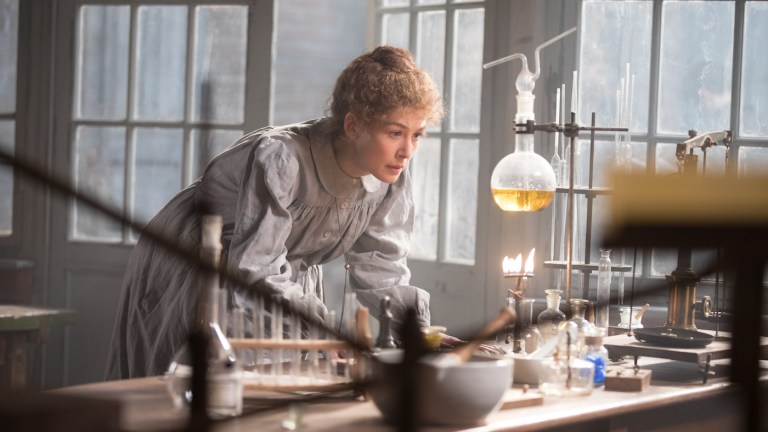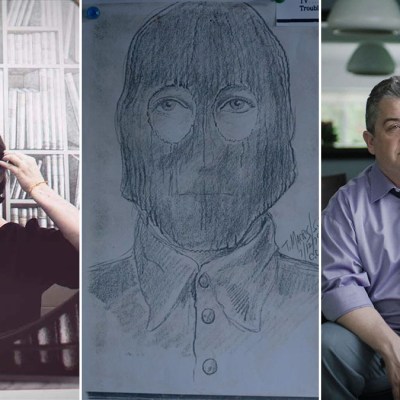Marjane Satrapi on Madame Curie: ‘Don’t Blame the Scientist’ for the Discovery
Filmmaker Marjane Satrapi discusses her Madame Curie biopic, Radioactive, and the legacy of a scientist whose discovery ushered in the nuclear age.

Madame Curie was part of Marjane Satrapi’s life well before Radioactive came along. In fact, she cannot remember a time when she didn’t know of Marie Curie, the Polish-French scientist who discovered two new elements on the periodic table, became the first person to win two Nobel Prizes, and coined the term “radioactivity” for the type of energy she hypothesized was emanating from the atom. It’s that kind of legacy Satrapi’s mother made sure her daughter was aware of while growing up in 1970s Tehran—a role model who, despite the disadvantages of living in the 19th century, could change the world by being “an independent woman and big and bad.”
Yet by making a biopic on Curie’s life, which becomes available on Amazon Prime later this week, Satrapi learned there was so much more to appreciate about the historic figure, including the parallels she saw with another woman who left her homeland to make a new life in Paris.
“We both came to France in our early 20s because we were not able to do what we wanted to do in our home countries,” Satrapi says about the echoes between her and Curie’s life. Indeed, Radioactive begins shortly after its protagonist immigrated to France in 1891, which makes for a kind of thematic continuation of Satrapi’s first film, the seminal animated movie Persepolis (2007), which acted as her autobiography about coming of age during the Iranian Revolution, and then being asked to leave for good by her parents after she was an adult.
“It’s not that they are waiting for [you],” Satrapi tells me about moving alone to a new country. “People have their life and they have their friends and family, and here you come. First of all, you have to make yourself [stand out]; you don’t have any connection, you don’t know anyone, so it’s more difficult for you. But then if you are a woman and you want to study science at the end of the 19th century? Then everything becomes more complicated. So I can understand this complication and how difficult it is to still be yourself… You have to fight because nobody is going to tell you, ‘Oh, you can stay. This is your place. Come and take it.’”
But taking it is what Radioactive details in a both straightforward and enigmatic manner. On the one hand, it is a biographical film about how a woman named Maria Salomea Sklodwska (Rosamund Pike) came to meet and marry fellow scientist Pierre Curie (Sam Riley), who by benefit of his gender could earn a doctorate in physics, and how he then helped advance her genius toward discovery—all while the study of radiation likely led to Pierre’s early death. At the same time, it’s interspersed with narrative interludes pointing toward the impact radiation had on the century to come.
This emphasis on the history of science and mathematics was part of the appeal for Satrapi, who pursued the project as soon as she heard Jack Thorne had written a screenplay about the Curies. For while Satrapi is quick to point out that she is personally not a genius, and Marie Curie was, the filmmaker still has always found the study of science and math to be a vital part of the human condition, even for an artist. Calling “bullshit” on those who undervalue science or think its emphasis on empirical fact-finding is separate from the creative side of the brain, the filmmaker considers curiosity central to creation and living.
“There is nothing more human than science,” Satrapi says. “How does the real world work? If we stop making discovery, if we stop being curious, then we will surely become big monkeys again.”
And the long-term effects of curiosity prove vital to Radioactive. Like the Lauren Redniss graphic novel it is based on, Radioactive: Marie & Pierre Curie: A Tale of Love and Fallout, the film is as interested in documenting the century-long journey of their life’s work as it is concerned with detailing simply their lives. Hence sections of the film that flash forward to the positive benefits of the discovery of radiation, such as how it’s used by radiologists to treat cancer, as well as sequences that recreate the day the Enola Gay flew over Hiroshima or when the Chernobyl power plant began melting down in 1986.
“You cannot talk about radioactivity and not talk about all of that,” Satrapi reflects. “Is that part of what Madame Curie created? Obviously not… [But] all of that is the result. You cannot actually talk about the couple who made the discovery, and how it is used to cure cancer, and then not talk about anything else, because of course they’re related, and this is the discovery that changed, completely, the face of the 20th century.”
To Satrapi it would be intellectually dishonest to show only the benefits caused by radiation in Curie’s lifetime—including during the third act when she invents with her daughter (Anya Taylor-Joy) mobilized radiology vehicles to perform X-rays at field hospitals during the First World War—but then ignore the atom bomb that came later. After all, this isn’t a simple discovery.
Says Satrapi, “If you discovered today a little type of blue octopus that lives in the depths of the Pacific Ocean, okay it’s a discovery, but would it change the world? No.” The Curies did. With that said, the filmmaker does not blame the Curies for what came after. Her movie is about finding what she calls an equilibrium toward their legacy.
“Frankly, I think the scientist does not have any responsibility,” Satrapi says. “The scientist has to discover. That is his job, to be curious and to discover. Now, if it were this way [suggested by critics], we can also say the first man who made the fire is responsible for all of the war in the world. Yeah, but he’s also responsible for the cooking of food and agriculture.”
Thus the parallels Satrapi sees between the Curies’ discovery with the current debate over the advancement of artificial intelligence.
“There’s some people that are against, some people that are for,” Satrapi considers. “Of course if you use it to make a very good heart surgery that no human’s hands can do without any risk, it’s fantastic. But if you use it to recognize the face of, I don’t know, some people somewhere in the world, and kill them without touching them, and call that declaring war, then it’s something disgusting. It’s the same thing. How do you use it? … It’s up to us, the human, to decide what we want to do with the discovery. I don’t think it’s the responsibility of the scientist. The scientist just discovers it.”
That sense of trying to find meaning in discovery, and life in general, is at the core of how Radioactive presents the Curies. Here were two people ahead of their time in countless ways, including with Pierre insisting that he’d only accept a Nobel Prize if his wife was also given credit for it (the Nobel Assembly initially refused to include Marie’s name on its award), yet they’re also products of it. Indeed, one of the most interesting aspects of the pair presented in the movie is their fascination with spiritualism. While Pierre is the much more active participant in 19th century séances, if only to attempt to locate a scientific pathway into the paranormal, Marie also turned to mediums after her husband’s death.
“The Curies, they were part of a [spiritualism] movement,” Satrapi says. “They asked, ‘So okay, maybe we don’t understand this, maybe we can be scientific and maybe we can explain it, and maybe something exists.’ And ‘maybe’ is the base of doubt, and doubt is the base of progress. So I love it. I really didn’t believe in it… [even though] I know that there’s some stuff that I don’t experience, because I only have five senses and that’s it.”
Yet that need for answers is, again, one of the things Satrapi says makes us human.
“The human being is the only animal who actually knows that he’s going to die,” says the director. “So it makes things very complex and at the same time complicated, and it gives them lots of problems.” Indeed, she traces much of humanity’s struggles over learning to be compassionate or empathetic to that knowledge of mortality. However, the filmmaker who also was forced to leave Iran as a young woman sincerely believes things are getting better in this world. Nuclear weapons or not.
“Frankly, I have faith in the human being,” she says. “People say, ‘Oh, it was much better before.’ But, much better before for who? In 1950, obviously if you were a man and you were white, and you were straight, it was great for you. But if you were a woman, if you were black, if you were homosexual, if you were all of that, it wasn’t good for you at all. We are living in a better world now. I mean, the world of before, it was war, war, war, war, and sometimes we had peace. The world of today is peace, peace, peace, peace, and sometimes we have war. We are progressing. This is work.”
And what of Madame Curie? What would the woman who lived through World War I think if she could see today, including the legacy of her discovery from the end of World War II to the many safe nuclear power plants lighting up France now?
Says Satrapi, “I think Marie was a very intelligent person, so she would look at you and say, “Yeah. This is it.”
Radioactive is available via Amazon Prime on Friday, July 24.


